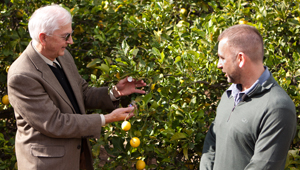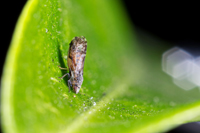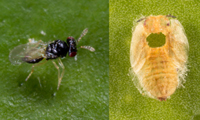

At 11:00 am on the 20 December 2011, approximately 30-40 people assembled at the UC Riverside Biological Control Grove to participate in the first release in California of the Asian citrus psyllid natural enemy, Tamarixiaradiata. Representatives from the University of California, California Department of Food and Agriculture, Citrus Research Board, and Citrus Pest and Disease Prevention Committee were in attendance. The event was covered by local media including Riverside’s Press Enterprise. After a brief introduction and description of the problem California faces with Asian citrus psyllid, and a quick review of the approximately two year process to reach this point, Mark Hoddle invited Provost and Executive Vice Chancellor Dallas Rabenstein to make the first release of Tamarixia in Southern California.
The Issue: In 2008, Asian citrus psyllid (ACP) was first found in California. This insect feeds on citrus and close relatives of citrus. The major problem with ACP is that is spreads a bacterium that causes a lethal disease in citrus known as Huanglongbing (HLB) . There is no cure for this disease. HLB is NOT in California.
ACP is widely established in LA County and pest populations are increasing and spreading in Riverside and San Bernardino Counties. This pest is almost exclusively restricted to backyard citrus. Spray programs to control ACP are difficult and expensive, and not every infested tree can be found and treated. Additional tools are needed for controlling ACP in California and biocontrol is one of these additional control options for ACP.

The Biocontrol Program: ACP is native to Asia and the Punjab of Pakistan and India and this area is thought to be part of the native range where this insect evolved. People have accidently moved this pest and HLB around the world through the accidental movement of infested citrus plants.
Over the last two years Mark and Christina Hoddle (Department of Entomology, University of California, Riverside) have worked in Faisalabad Pakistan looking for natural enemies of ACP. Faisalabad Pakistan was chosen for this research effort because this part of Pakistan has a very good climate match (~70-75%) with the major citrus producing areas of California which will mean the natural enemies released in California will be pre-adapted to very hot dry summers and cold foggy winters.
An ACP Natural Enemy from Pakistan: One parasitoid found attacking ACP in the Punjab of Paksitan is Tamarixia radiata. This is a very small insect that kills ACP nymphs either by parasitizing them (i.e., females eggs laid underneath ACP nymphs and the parasitoid larvae burrow into the nymph to feed which kills the pest) or by host feeding (i.e., female parasitoids stab the nymph with their ovipositor, a tube that they use to lay eggs, and they feed on the body juices that leak from these wounds. This kills the nymph too.)

Quarantine Studies: Safety tests conducted by Dr. Raju Pandey in Quarantine at UC Riverside clearly demonstrated that this parasitoid posed no undue risk to California’s environment, other species of insects, or humans. A 60 page Environment Assessment Report on Tamarixia that summarized the results of these studies was prepared by Mark Hoddle and Raju Pandey for review by USDA-APHIS. On 7 December 2012, APHIS issued a permit (P526P-11-04159) authorizing the release of Tamarixia from Quarantine for establishment in California for the biological control of ACP.
The Release Event: On 20 December 2011 at 11:00am, 12 glass vials containing 186 female Tamarixia and 95 male Tamarixia (total 281 parasitoids) were opened to release the parasitoids in the Biocontrol Grove at UC Riverside. The eight colonies in Quarantine from which these parasitoids were sourced for release were tested using DNA analyses to ensure that they were free of the bacterium that causes HLB. All tests were negative for HLB indicating that the parasitoids were free of this bacterium.
The Biocontrol Grove is a repository for natural enemies that have been imported for the biological control of citrus pests (e.g., scales, mealybugs, whiteflies, etc) in California over the last 50+ years. With the releases of Tamarixia in the Biocontrol Grove, one more natural enemy is being established here to combat an invasive pest that threatens California’s agricultural prosperity.
Expected Outcomes: This release of 281 Tamarixia is the first salvo against ACP in California. Over the next year or so it is anticipated that thousands of these parasitoids from Pakistan will be mass reared and released throughout LA, Riverside, and San Bernardino Counties and other areas as the pest continues to spread. Once Tamarixiaestablishes it will move by itself to find new populations of ACP to attack and kill. The parasitoids will have the ability to enter areas to kill ACP that may be difficult or impossible to reach for pesticide applications.
Tamarixia will *NOT* eradicate ACP from California but this natural enemy should reduce the populations of ACP in California. Every ACP killed by Tamarixia will be one less pest for homeowners and commercial citrus growers to worry about.
For More Information: These websites have more information on ACP and the work in Pakistan looking for natural enemies of ACP.
http://cisr.ucr.edu/asian_citrus_psyllid.html
http://cisr.ucr.edu/citrus_greening.html
http://cisr.ucr.edu/blog/psyllids/hunting-for-natural-enemies-of-asian-citrus-psyllid-in-pakistan/